Increasing force transmissibility for tactile feedback interface devices
a technology of tactile feedback and transmittance, which is applied in the direction of static indicating devices, instruments, sport apparatus, etc., can solve the problems of inability to accurately measure, force is not as crisp, precise, or controllable, and the transmittance of tactile feedback is limited. , to achieve the effect of increasing the transmissibility of inertial forces
- Summary
- Abstract
- Description
- Claims
- Application Information
AI Technical Summary
Benefits of technology
Problems solved by technology
Method used
Image
Examples
embodiment 250
[0059]FIG. 7 shows a diagrammatic illustration of an embodiment 250 of an inertial tactile feedback system of the present invention, where an eccentric mass 252 or other inertial device (i.e. a linkage or other mechanism for providing mass, e.g., a linkage providing one particular vibration response in one direction and a different response in the other direction of rotation) is mounted on the rotatable shaft 254 of an actuator 256 such as a motor. The mass 252 rotates about an axis A. The motor housing is rigidly coupled to a motor bracket 258, and the motor bracket 258 is compliantly coupled to the device housing 260 (suspended) by one or more spring elements 262. The device housing is held or otherwise physically contacted by the user.
[0060]The spring elements 262 can take a variety of different forms, including helical springs, leaf springs, compliant members, diaphragms, or other types of elements. The compliance of the springs have been chosen such that the resonance frequency...
embodiment 300
[0063]FIG. 8 illustrates an example of a specific embodiment 300 of the invention, in which a compliance mechanism 301 is formed as a single piece with the housing of the device. A rotary motor 302 having an eccentric mass 304 is rigidly coupled to a motor bracket 306. The motor bracket 306 is coupled to the housing 308 of the device by spring beams 310, where the spring beams 310 are preferably integrated in the same unitary material as the bracket 306 and the housing 308. This allows the entire suspension, including beams 310 and bracket 306, to be molded as a single piece with the housing 308, thus greatly reducing manufacturing and assembly cost. The housing 308, bracket 306, and spring beams 310 can be made of a plastic having the desired compliance, for example. The spring beams 310 can be designed at the proper width and length to provide the desired spring constant and amplification range to inertial forces produced by the actuator. Furthermore, flex joints can be provided a...
embodiment 350
[0064]Another embodiment 350 is shown in FIG. 9. A base mass 352 is approximately matched to the mass of a gamepad controller. A motor 354 having an ERM 356 is coupled to the base 352 by a leaf spring 358 to provide the compliance between motor and housing. This prototype was placed on a foam layer so that an accelerometer attached to the base could be used to measure the transmitted force. In the test, the base was rotated vertically so that the motor vibrations acted against the leaf spring's most compliant axis.
[0065]As expected, when the motor was harmonically driven with a sine function, the magnitude of the housing acceleration could be maximized by altering the leaf spring suspension stiffness. For instance, by tuning spring stiffness to maximize peak output force at 80 Hz resonance, it was possible to boost the acceleration measured on the base everywhere below that frequency, thus providing higher-magnitude vibrations. This process was repeated for several natural frequenci...
PUM
 Login to View More
Login to View More Abstract
Description
Claims
Application Information
 Login to View More
Login to View More - R&D
- Intellectual Property
- Life Sciences
- Materials
- Tech Scout
- Unparalleled Data Quality
- Higher Quality Content
- 60% Fewer Hallucinations
Browse by: Latest US Patents, China's latest patents, Technical Efficacy Thesaurus, Application Domain, Technology Topic, Popular Technical Reports.
© 2025 PatSnap. All rights reserved.Legal|Privacy policy|Modern Slavery Act Transparency Statement|Sitemap|About US| Contact US: help@patsnap.com



